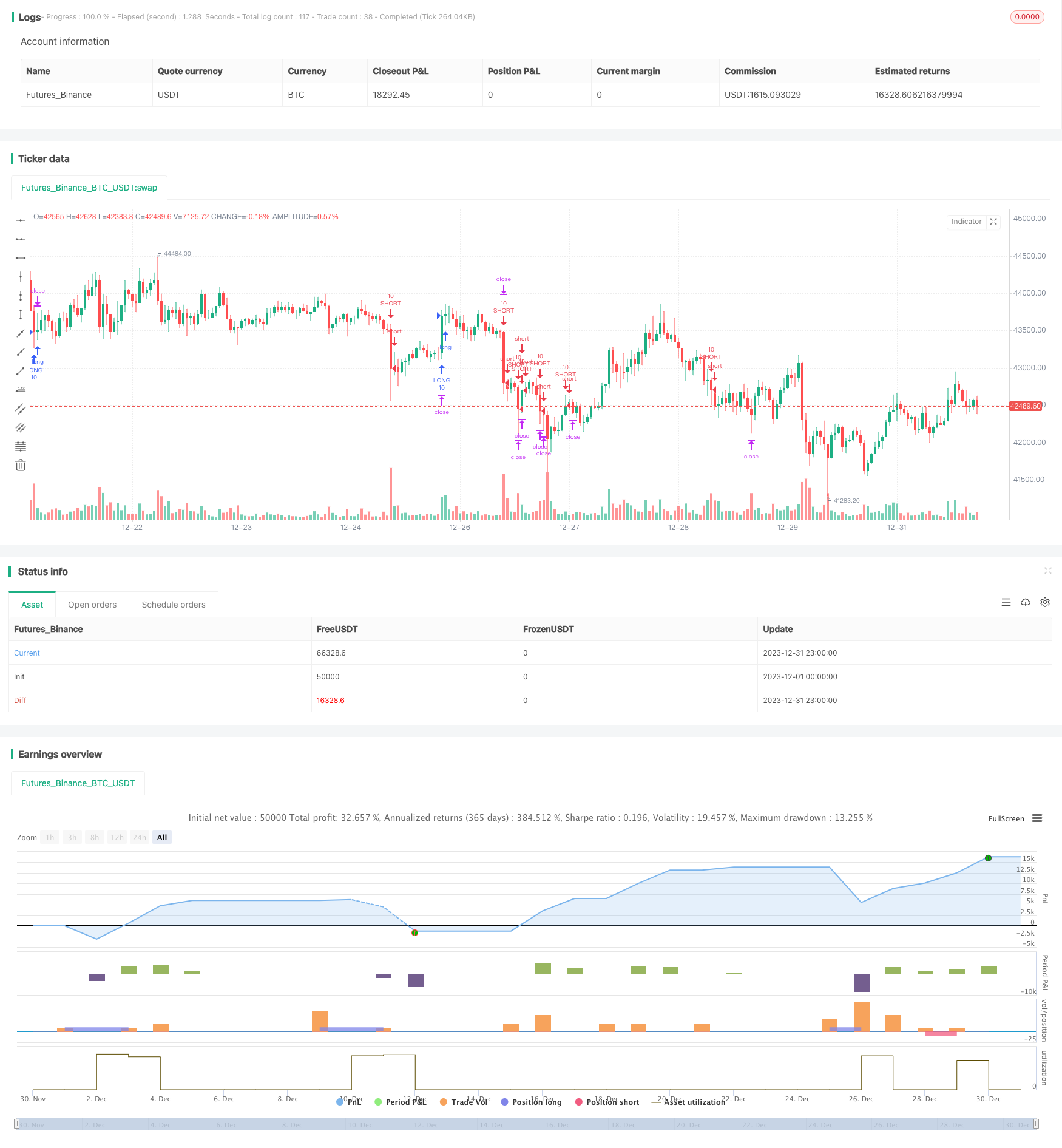
概述
本策略基于前一天的收盘价以及ATR指标设定多空头开仓价位和止损价位,实现对趋势的追踪。当价格突破开仓价位时开仓做多做空,止损或止盈后清仓。
策略原理
本策略使用前一天的收盘价、最高价、最低价以及ATR指标计算入场价位和止损价位。具体计算公式如下:
多头开仓价位 TPup = 前一天收盘价 + ATR * 0.8 空头开仓价位 TPdown = 前一天收盘价 - ATR * 0.8
多头止损价位 slup = 前一天收盘价 + ATR * 0.2 空头止损价位 sldown = 前一天收盘价 - ATR * 0.2
多头止盈价位 profitlevelup = 前一天最低价 + ATR * 1.7
空头止盈价位 profitleveldown = 前一天最高价 - ATR * 1.7
当价格突破多头开仓价位 TPup 时,按照 10 手数做多;当价格突破空头开仓价位 TPdown 时,按照 10 手数做空。之后设置止损和止盈,价格触及止损价位后止损清仓,触及止盈价位后止盈清仓。
优势分析
本策略主要优势有:
使用ATR指标设定动态的开仓价位和止损价位,可以根据市场波动度进行调整,使交易更加适应市场环境。
利用前一天收盘价确定方向,再结合ATR指标确定具体的交易价位,避免被噪音太多的实时价格误导。
同时设置止损和止盈机制,可以很好控制单笔交易的风险。
风险分析
本策略主要风险有:
ATR指标设定的价位可能过于理想化,无法真正反映市场情况,导致频繁止损。可以适当调整ATR参数或加大止损幅度。
前一天收盘价无法确定未来趋势,如果出现剧烈反转,会误导交易方向选择。可以考虑结合其他指标确认趋势。
止损和止盈位置可能被操纵触发,无法真正止损。可以设置成分批止损,避免被套。
优化方向
本策略可以从以下几个方面进行优化:
优化ATR参数,使交易价位更符合市场波动性。
增加趋势判断机制,避免交易反转市。例如结合MA等指标。
调整止盈幅度,在保持盈利性的同时减少盈利点被触发的概率。
设置成分批止损和止盈,降低被套和损失的概率。
增加仓位管理机制,可以加大趋势阶段的仓位。
总结
本策略基于前一天收盘价和ATR指标设定动态的交易价位,实现对趋势的有效跟踪。同时设置止损和止盈机制控制单笔交易的风险。优化方向包括参数优化、判断机制增加、止盈调整以及仓位管理等。总体来说,本策略较好地实现了追趋势交易的效果。
/*backtest
start: 2023-12-01 00:00:00
end: 2023-12-31 23:59:59
period: 1h
basePeriod: 15m
exchanges: [{"eid":"Futures_Binance","currency":"BTC_USDT"}]
*/
//@version=3
strategy("PC with ATR Strategy (by Zhipengcfel)", shorttitle="PC_ATR", pyramiding=1, overlay=true)
// Zhipengcfel's Previous day's close with ATR Strategy
//
// Version 1.0
// @copyright Idea by Zhipengcfel on June 29, 2017.
//Previous day's close plus ATR strategy.
//Buy (if breaking PC+ATR*0.8) or sell (if breaking PC-0.8*ATR).
//This is just a demo vision and can not be used for real auto trading
///////////// ATR value
ATRlength = input(14, minval=1, title="lookback length of ATR")
//ATR = atr(ATRlength)
ATR = request.security(syminfo.tickerid, 'D', atr(ATRlength))
///////////// Entry levels and target levels
entr = input(0.8, minval=0.1, step = 0.05, title="Entry level for ATR")
tplevel = input(1.7, minval=0.1, step = 0.05, title="Exit level for ATR")
yesterday = request.security(syminfo.tickerid, 'D', close[1])
dl = request.security(syminfo.tickerid, 'D', low[1])
dh = request.security(syminfo.tickerid, 'D', high[1])
TPup = yesterday+entr*ATR
TPdown = yesterday-entr*ATR
profitlevelup = dl+tplevel*ATR
profitleveldown = dh-tplevel*ATR
///////////// Stop loss level
sl = input( 0.2 ,minval=0.01, step = 0.05, title="Stop loss level for ATR") //82 for 2, 83 for 3 and more positions
slup = yesterday+sl*ATR
sldown = yesterday-sl*ATR
///////////// Starting year to backtest
yer = input( 2014 , title="Backtest Starting year")
///////////// strategy: PC + ATR
if (close > TPup) and (close < profitlevelup)
strategy.entry("LONG", strategy.long, 10, comment="Buy", when = year > yer, oca_name="My oca")
strategy.exit("Stopped", "LONG", stop = slup, limit= profitlevelup, oca_name="My oca")
if (close < TPdown) and (close > profitleveldown)
strategy.entry("SHORT", strategy.short, 10, comment="Sell", when = year > yer, oca_name="My oca")
strategy.exit("Stopped", "SHORT", stop = sldown, limit= profitleveldown, oca_name="My oca")